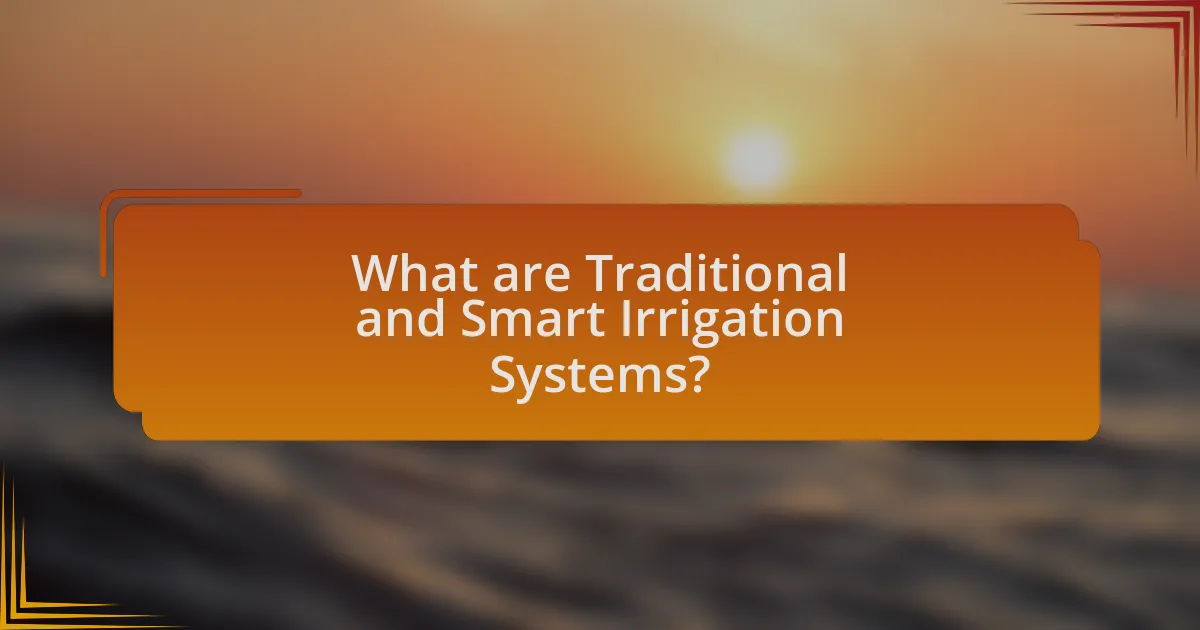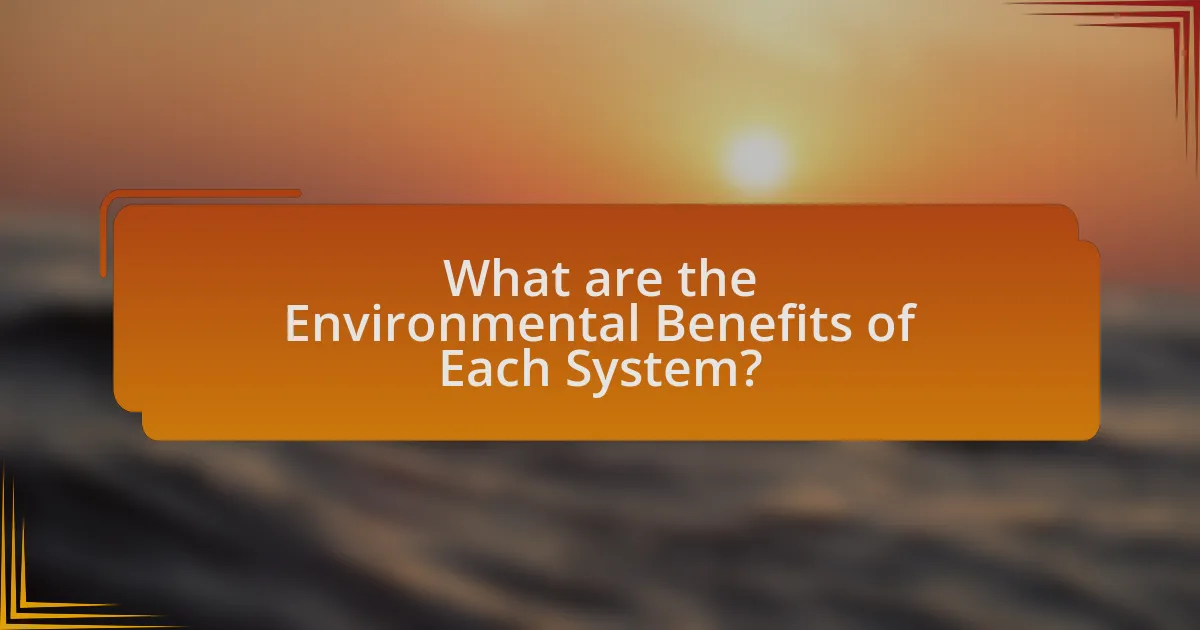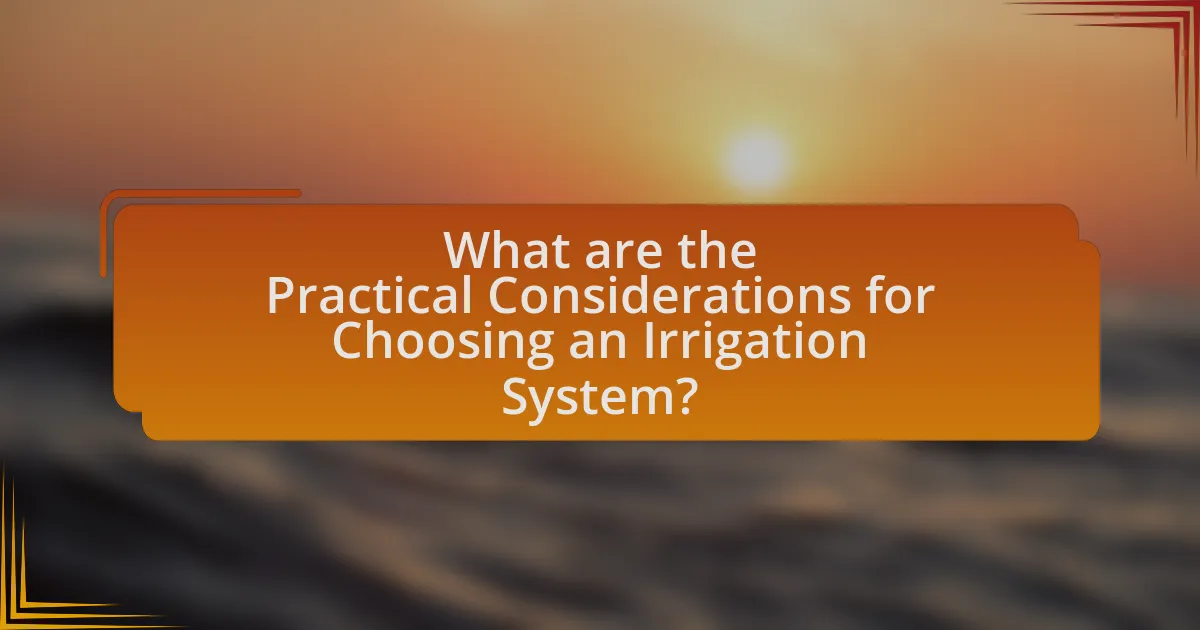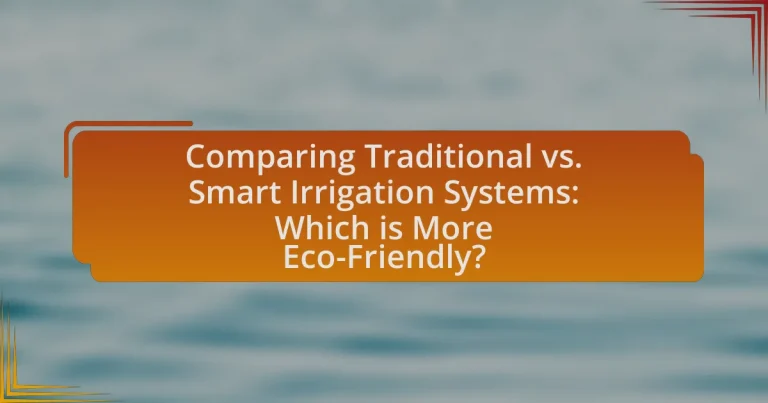The article compares traditional and smart irrigation systems, focusing on their eco-friendliness and efficiency in water usage. Traditional irrigation methods, such as surface and flood irrigation, often lead to water wastage and uneven distribution, while smart irrigation systems utilize advanced technologies like sensors and automated controls to optimize water application based on real-time data. Key components, operational methods, environmental impacts, and maintenance requirements of both systems are examined, highlighting the significant water savings and sustainability benefits of smart irrigation. The article emphasizes the importance of choosing the right irrigation system for effective water conservation and environmental protection.
What are Traditional and Smart Irrigation Systems?

Traditional irrigation systems refer to conventional methods of watering crops, such as surface irrigation, furrow irrigation, and flood irrigation, which rely on gravity to distribute water. These systems often lead to water wastage and uneven distribution, as they do not utilize advanced technology to monitor soil moisture or weather conditions.
Smart irrigation systems, on the other hand, incorporate technology such as sensors, timers, and automated controllers to optimize water usage based on real-time data. These systems can significantly reduce water consumption by applying water only when necessary, thus promoting efficiency and sustainability in agricultural practices. Studies indicate that smart irrigation can reduce water use by up to 30% compared to traditional methods, making it a more eco-friendly option.
How do Traditional Irrigation Systems operate?
Traditional irrigation systems operate by utilizing natural water sources, such as rivers, lakes, or groundwater, to deliver water to crops through various methods. These systems often include techniques like surface irrigation, where water flows over the soil surface, and furrow irrigation, where water is directed into small channels between rows of crops. Historical evidence shows that these methods have been used for thousands of years, with ancient civilizations like the Mesopotamians and Egyptians employing similar techniques to sustain agriculture. The effectiveness of traditional irrigation is often influenced by local climate, soil type, and crop requirements, making it a context-dependent practice.
What are the key components of Traditional Irrigation Systems?
The key components of Traditional Irrigation Systems include canals, ditches, wells, and reservoirs. Canals and ditches are used to transport water from a source to agricultural fields, while wells provide groundwater access. Reservoirs store water for later use, ensuring a consistent supply during dry periods. These components have been utilized for centuries, with historical evidence showing their effectiveness in various cultures for sustaining agriculture.
What are the common methods used in Traditional Irrigation?
Common methods used in traditional irrigation include surface irrigation, drip irrigation, and flood irrigation. Surface irrigation involves the distribution of water over the soil surface by gravity, allowing it to infiltrate into the soil. Drip irrigation delivers water directly to the root zone of plants through a network of tubing and emitters, minimizing evaporation and runoff. Flood irrigation, often used in rice cultivation, inundates the field with water, allowing it to soak into the soil. These methods have been utilized for centuries and are foundational to agricultural practices worldwide.
What defines Smart Irrigation Systems?
Smart Irrigation Systems are advanced technologies designed to optimize water usage for irrigation by utilizing data-driven methods. These systems incorporate sensors, weather data, and automated controls to deliver precise amounts of water based on real-time conditions, significantly reducing water waste. Research indicates that Smart Irrigation Systems can reduce water usage by up to 30% compared to traditional methods, demonstrating their efficiency and eco-friendliness.
What technologies are integrated into Smart Irrigation Systems?
Smart Irrigation Systems integrate various technologies such as soil moisture sensors, weather-based controllers, and automated irrigation scheduling. Soil moisture sensors measure the moisture level in the soil, allowing for precise watering based on actual needs rather than a fixed schedule. Weather-based controllers utilize local weather data to adjust irrigation schedules, preventing overwatering during rainy periods. Automated irrigation scheduling systems can be programmed to optimize water usage based on plant requirements and environmental conditions, enhancing efficiency and sustainability in water management. These technologies collectively contribute to reducing water waste and improving crop health.
How do Smart Irrigation Systems differ from Traditional ones?
Smart irrigation systems differ from traditional ones primarily in their use of technology to optimize water usage. Traditional irrigation systems typically operate on fixed schedules, applying water regardless of weather conditions or soil moisture levels, which can lead to overwatering or underwatering. In contrast, smart irrigation systems utilize sensors, weather data, and automated controls to adjust watering schedules based on real-time environmental conditions, significantly improving water efficiency. For instance, studies have shown that smart irrigation can reduce water usage by up to 30% compared to traditional methods, demonstrating their effectiveness in promoting sustainable water management.
Why is it important to compare these irrigation systems?
Comparing irrigation systems is important to determine their efficiency, sustainability, and environmental impact. Traditional irrigation systems often waste water and resources, while smart irrigation systems utilize technology to optimize water usage, reducing waste and promoting eco-friendliness. Studies indicate that smart irrigation can reduce water consumption by up to 30% compared to traditional methods, highlighting the significance of this comparison in promoting sustainable agricultural practices.
What environmental impacts do both systems have?
Traditional irrigation systems typically lead to higher water wastage and increased soil salinity due to inefficient water distribution, while smart irrigation systems optimize water usage through technology, significantly reducing water consumption and minimizing runoff. Research indicates that smart irrigation can reduce water use by up to 30% compared to traditional methods, thereby lowering the environmental impact associated with water scarcity and promoting healthier soil conditions. Additionally, traditional systems often contribute to habitat degradation and increased greenhouse gas emissions due to over-irrigation, whereas smart systems enhance sustainability by utilizing weather data and soil moisture sensors to apply water only when necessary, thus preserving ecosystems and reducing carbon footprints.
How do water conservation efforts differ between the two systems?
Water conservation efforts differ significantly between traditional and smart irrigation systems. Traditional irrigation systems often rely on fixed schedules and manual adjustments, leading to inefficient water use and potential overwatering, which can waste up to 50% of water in some cases. In contrast, smart irrigation systems utilize technology such as soil moisture sensors and weather data to optimize water application, resulting in water savings of 20-50% compared to traditional methods. This efficiency is supported by studies indicating that smart systems can reduce water consumption while maintaining crop health, demonstrating their superior effectiveness in conservation efforts.
What are the Environmental Benefits of Each System?

Smart irrigation systems provide significant environmental benefits compared to traditional irrigation systems. These benefits include reduced water consumption, as smart systems utilize sensors and weather data to optimize watering schedules, leading to up to 30% less water usage. Additionally, smart irrigation minimizes runoff and soil erosion by delivering water directly to the root zone, which enhances soil health and reduces the need for chemical fertilizers. In contrast, traditional systems often lead to overwatering, which can contribute to water waste and environmental degradation. Studies indicate that implementing smart irrigation can decrease water usage in agricultural practices by 20-50%, demonstrating its effectiveness in promoting sustainable water management.
How do Traditional Irrigation Systems impact the environment?
Traditional irrigation systems significantly impact the environment by altering natural water flow and affecting local ecosystems. These systems often lead to waterlogging and salinization of soil, which can degrade agricultural productivity and harm plant biodiversity. For instance, excessive water application can result in the accumulation of salts in the soil, making it less fertile over time. Additionally, traditional irrigation methods can contribute to the depletion of local water sources, as they typically rely on surface water that may not be replenished at the same rate it is extracted. This can lead to reduced water availability for other ecological and human needs, further stressing the environment.
What are the drawbacks of Traditional Irrigation Systems?
Traditional irrigation systems have several drawbacks, including inefficiency in water usage, high labor costs, and potential for soil degradation. These systems often rely on surface irrigation methods, which can lead to significant water loss through evaporation and runoff, resulting in only 40-60% of water being effectively used for crops. Additionally, traditional methods require substantial manual labor for setup and maintenance, increasing operational costs. Over time, these systems can also contribute to soil salinization and nutrient depletion, negatively impacting soil health and crop yields.
How does Traditional Irrigation contribute to water wastage?
Traditional irrigation contributes to water wastage primarily through inefficient water application methods. These methods often involve surface irrigation techniques, such as flood or furrow irrigation, which can lead to significant evaporation and runoff losses. Research indicates that traditional irrigation systems can waste up to 50% of the water applied due to these inefficiencies, as water is not effectively delivered to the root zones of plants. Additionally, the lack of precise control over water distribution in traditional systems exacerbates the problem, resulting in overwatering and further wastage.
What are the eco-friendly features of Smart Irrigation Systems?
Smart Irrigation Systems incorporate several eco-friendly features that significantly reduce water waste and promote sustainable water management. These systems utilize advanced technologies such as soil moisture sensors, weather data integration, and automated scheduling to optimize irrigation schedules based on real-time environmental conditions. For instance, soil moisture sensors measure the moisture level in the soil, ensuring that water is only applied when necessary, which can lead to water savings of up to 50% compared to traditional irrigation methods. Additionally, weather data integration allows these systems to adjust watering schedules based on rainfall forecasts, further minimizing unnecessary water usage. Overall, Smart Irrigation Systems enhance water efficiency and contribute to environmental conservation by reducing the overall demand for water resources.
How do Smart Irrigation Systems promote water efficiency?
Smart Irrigation Systems promote water efficiency by utilizing advanced technology to optimize water usage based on real-time data. These systems employ sensors and weather forecasts to determine the precise amount of water needed for plants, significantly reducing overwatering and runoff. Research indicates that Smart Irrigation Systems can reduce water consumption by up to 30% compared to traditional methods, as they adjust irrigation schedules and amounts according to environmental conditions. This targeted approach not only conserves water but also enhances plant health and growth, demonstrating their effectiveness in promoting sustainable water management practices.
What role does technology play in reducing environmental impact?
Technology plays a crucial role in reducing environmental impact by enhancing efficiency and minimizing resource waste. For instance, smart irrigation systems utilize sensors and data analytics to optimize water usage, significantly decreasing water consumption by up to 50% compared to traditional methods. This reduction in water usage not only conserves a vital resource but also lowers energy consumption associated with water transport and treatment. Additionally, technology facilitates precision agriculture, which employs GPS and IoT devices to apply fertilizers and pesticides more accurately, thereby reducing chemical runoff into ecosystems. These advancements demonstrate that technology is instrumental in promoting sustainable practices and mitigating environmental degradation.
Which system is more sustainable in the long run?
Smart irrigation systems are more sustainable in the long run compared to traditional irrigation systems. Smart irrigation utilizes advanced technologies such as sensors, weather data, and automated controls to optimize water usage, significantly reducing water waste. Research indicates that smart irrigation can reduce water consumption by up to 30% to 50% compared to traditional methods, which often lead to overwatering and inefficient resource use. Additionally, smart systems can adapt to changing environmental conditions, ensuring that water is applied only when necessary, further enhancing sustainability.
What factors contribute to the sustainability of each system?
The sustainability of traditional and smart irrigation systems is influenced by several key factors. Traditional irrigation systems often rely on surface water and can lead to water wastage due to evaporation and runoff, which diminishes their sustainability. In contrast, smart irrigation systems utilize technology such as soil moisture sensors and weather data to optimize water usage, significantly reducing waste and promoting efficient water management.
Additionally, the energy consumption associated with each system plays a crucial role; traditional systems may require more energy for pumping and distribution, while smart systems can operate more efficiently, often using renewable energy sources. The adaptability of each system to local environmental conditions also affects sustainability; smart systems can be tailored to specific crops and climates, enhancing their effectiveness and reducing resource depletion.
Research indicates that smart irrigation can reduce water usage by up to 30% compared to traditional methods, demonstrating a clear advantage in sustainability. Therefore, the combination of efficient water use, energy consumption, and adaptability are critical factors that contribute to the sustainability of each irrigation system.
How do user practices influence the eco-friendliness of each system?
User practices significantly influence the eco-friendliness of irrigation systems by determining water usage efficiency and energy consumption. In traditional irrigation systems, practices such as overwatering and inefficient scheduling lead to water wastage and increased energy use for pumping, resulting in a higher environmental impact. Conversely, smart irrigation systems utilize user practices like real-time monitoring and automated scheduling based on weather data, which optimize water usage and reduce energy consumption. Studies show that smart irrigation can reduce water usage by up to 30% compared to traditional methods, demonstrating a clear link between user practices and eco-friendliness in irrigation systems.
What are the Practical Considerations for Choosing an Irrigation System?

Practical considerations for choosing an irrigation system include water availability, soil type, crop requirements, and system efficiency. Water availability determines the feasibility of certain systems, while soil type affects how water is absorbed and retained. Crop requirements dictate the amount and frequency of irrigation needed, ensuring that plants receive adequate moisture for optimal growth. System efficiency, which can be measured by water usage and distribution uniformity, impacts both resource conservation and cost-effectiveness. For instance, drip irrigation systems are often more efficient than traditional sprinkler systems, reducing water waste and promoting sustainable practices.
What factors should be considered when selecting an irrigation system?
When selecting an irrigation system, key factors include water source availability, soil type, crop requirements, system efficiency, and cost. Water source availability determines the sustainability of the irrigation system, while soil type affects water retention and drainage. Crop requirements dictate the amount and frequency of water needed, influencing the choice of system. System efficiency, measured by water usage and distribution uniformity, impacts overall effectiveness and environmental sustainability. Cost considerations encompass both initial investment and long-term operational expenses, which are critical for economic viability.
How does the size of the area affect the choice of irrigation system?
The size of the area significantly influences the choice of irrigation system, as larger areas typically require more efficient and scalable solutions. For instance, extensive agricultural fields often benefit from centralized systems like pivot irrigation, which can cover vast distances with minimal labor and water waste. In contrast, smaller plots may utilize drip or sprinkler systems that are easier to manage and install. Research indicates that larger areas can lead to economies of scale, making automated systems more cost-effective over time, while smaller areas may prioritize flexibility and lower initial investment. Thus, the area size directly impacts both the type and efficiency of the irrigation system selected.
What budget considerations are important for both systems?
Budget considerations for both traditional and smart irrigation systems include initial installation costs, ongoing maintenance expenses, and potential water savings. Traditional systems typically have lower upfront costs but may incur higher long-term water bills due to inefficiencies. In contrast, smart irrigation systems often require a higher initial investment for technology and installation but can lead to significant water savings and reduced utility costs over time. Studies indicate that smart systems can reduce water usage by up to 30%, providing a return on investment that offsets their higher initial costs.
What are the maintenance requirements for each system?
Traditional irrigation systems require regular maintenance, including checking for leaks, cleaning filters, and adjusting sprinkler heads to ensure even water distribution. These tasks are essential to prevent water waste and maintain system efficiency. In contrast, smart irrigation systems demand less frequent maintenance due to their automated features, which include self-diagnostics and weather-based adjustments. However, they still require periodic software updates and sensor calibration to optimize performance. The reduced maintenance frequency of smart systems can lead to lower long-term operational costs and improved water conservation.
How does maintenance differ between Traditional and Smart Irrigation Systems?
Maintenance for Traditional Irrigation Systems typically involves manual checks and repairs, while Smart Irrigation Systems require less frequent but more technical maintenance due to their reliance on technology. Traditional systems often need regular inspections of pipes, valves, and emitters to prevent clogs and leaks, which can be labor-intensive and time-consuming. In contrast, Smart Irrigation Systems utilize sensors and automated controls that can self-diagnose issues, allowing for remote monitoring and adjustments, thus reducing the need for on-site maintenance. This difference in maintenance is supported by studies indicating that Smart Systems can lead to a 30% reduction in water usage, highlighting their efficiency and lower maintenance demands compared to traditional methods.
What common issues arise with each system?
Common issues that arise with traditional irrigation systems include water wastage due to inefficient distribution and reliance on manual operation, which can lead to inconsistent watering schedules. Additionally, traditional systems often suffer from poor adaptability to varying weather conditions, resulting in either overwatering or underwatering crops.
In contrast, smart irrigation systems face challenges such as high initial costs for installation and maintenance, as well as potential technical issues related to software and hardware malfunctions. Furthermore, smart systems may require reliable internet connectivity, which can be a limitation in rural areas.
Both systems can also encounter problems with soil salinity and nutrient leaching, impacting crop health and yield.
What tips can help in making an eco-friendly choice?
To make an eco-friendly choice, prioritize the use of smart irrigation systems over traditional methods. Smart irrigation systems utilize technology such as soil moisture sensors and weather data to optimize water usage, reducing waste by up to 50% compared to conventional irrigation methods. This efficiency not only conserves water but also minimizes energy consumption associated with pumping and distributing water. Additionally, selecting native plants for landscaping can further enhance eco-friendliness, as these plants require less water and maintenance, promoting biodiversity and reducing the need for chemical fertilizers and pesticides.
How can users maximize the efficiency of their chosen irrigation system?
Users can maximize the efficiency of their chosen irrigation system by implementing precise scheduling and utilizing technology for monitoring soil moisture levels. Precise scheduling ensures that water is applied only when necessary, reducing waste and promoting healthy plant growth. Additionally, using sensors and smart controllers allows users to adjust irrigation based on real-time data, which can lead to water savings of up to 30% compared to traditional methods. Studies have shown that smart irrigation systems can significantly enhance water use efficiency, making them a more eco-friendly option.
What best practices should be followed for sustainable irrigation?
Best practices for sustainable irrigation include implementing drip irrigation systems, utilizing rainwater harvesting, scheduling irrigation based on weather forecasts, and employing soil moisture sensors. Drip irrigation delivers water directly to the plant roots, minimizing evaporation and runoff, which can save up to 50% more water compared to traditional methods. Rainwater harvesting captures and stores rainwater for irrigation, reducing reliance on groundwater and municipal supplies. Scheduling irrigation according to weather forecasts prevents overwatering, while soil moisture sensors provide real-time data to optimize water usage. These practices collectively enhance water efficiency and promote environmental sustainability in agricultural practices.


